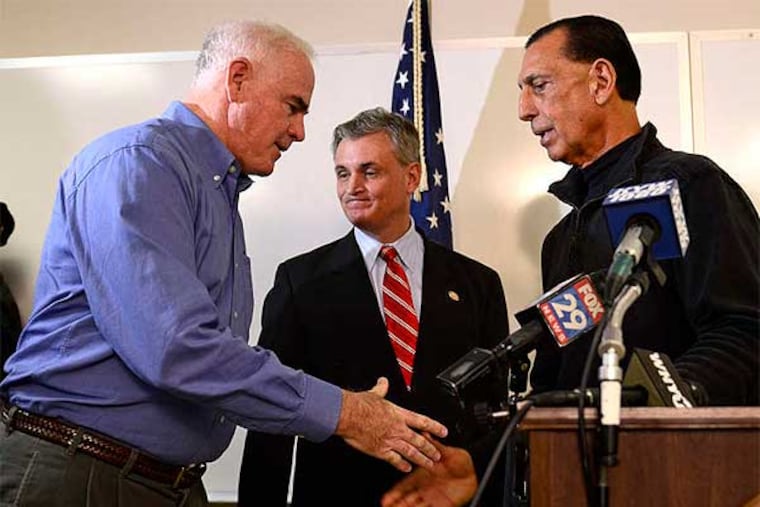Ruptured train car in Paulsboro free of chemical; no word on when evacuees can return
The Coast Guard said Thursday that cleanup crews have removed all traces of vinyl chloride from a freight-train tanker that fell off a bridge and breached last Friday, and that hazardous chemical has not been detected in the atmosphere in Paulsboro since Tuesday afternoon.

The Coast Guard said cleanup crews have removed all traces of vinyl chloride from a freight-train tanker that fell off a bridge and breached last Friday, and that the hazardous chemical has not been detected in the atmosphere in Paulsboro since Tuesday afternoon.
But Coast Guard Capt. Kathy Moore, at a news conference, would not specify when the hundreds of evacuees could expect to return home, though she previously set Sunday as the target date.
And even as workers made progress in the cleanup effort, three local congressmen held a news conference Thursday morning to say they would investigate the accident.
"We are moving well along in being able to get people back in their homes," Moore said. "I cannot tell you that we are for certain going to be able to do that at a particular time. We are working swiftly in that direction."
The evacuation of nearly 700 residents - ordered after the railroad bridge over the Mantua Creek failed, derailing the train and rupturing the tank car loaded with the hazardous chemical - will not be ended until officials are "absolutely certain that the risk in the community has been completely eliminated," she said.
Officials still need to verify three other cars of vinyl chloride have not been breached and determine that the site is safe before they can begin lifting the railcars out of the water.
As of Monday night, officials from the Coast Guard, which is leading the emergency response, and the Environmental Protection Agency were still detecting vinyl chloride levels in the atmosphere ranging up to five parts per million. The federal Occupational Safety and Health Administration considers short-term exposure to such levels dangerous.
Cleanup crews finished removing vinyl chloride from the breached tank car about 6 p.m. Wednesday, Moore said, raising questions about why officials did not notify residents of that development until late Thursday.
Residents forcefully complained Wednesday night at a town-hall meeting, saying Coast Guard officials and others had not effectively kept them abreast of the situation.
Moore said she did not consider the car safe until Thursday afternoon, after it was pumped full of acetone and steam-cleaned.
"I don't want to create a false impression that we've started something and then it stops," she said. "That creates an expectation that we're not making progress."
A 150-ton crane owned by Weeks Marine, a maritime construction and dredging company that removed US Airways Flight 1549 from the Hudson River after it crash-landed in 2009, is on a barge at the scene and will be used to remove the derailed cars.
Workers dissolved the vinyl chloride by pumping 3,000 gallons of acetone, a neutralizing chemical, into the car. They then pumped the mixture into another railcar, which has since been removed.
Once the Coast Guard determines the area is safe for evacuees to return, officials will monitor the air in residents' houses, first for volatile organic compounds, Moore said, and then specifically for vinyl chloride.
They will ventilate any affected homes, Moore said, and will clear them for occupation only when the chemical is not detectable.
Earlier on Thursday, the three members of Congress said questions remained about why the wreck happened and how quickly the damaged bridge can be repaired.
U.S. Rep. Robert E. Andrews (D., N.J.) also called for independent inspections of rail bridges, in exchange for federal aid in rebuilding or rehabbing the bridges.
Andrews and U.S. Reps. Patrick Meehan (R., Pa.) and Frank LoBiondo (R., N.J.) met with recovery officials near the accident site.
"We want this to be done safely and quickly, in that order," Andrews said.
He jokingly told Paulsboro Council President John Giovannitti that Paulsboro High School's renowned wrestling team could help:
"We should just get the wrestling team all out there. They could just lift that thing right up."
Meehan, who serves on a congressional subcommittee on railroads, pipelines, and hazardous materials, said he expected congressional hearings into the accident.
A former U.S. attorney in Philadelphia, Meehan said inquiries would focus on "how did this occur in the first place . . . and what should we be doing to prevent it" from happening again.
LoBiondo said "extraordinary measures are being taken to try to get to the bottom of this. We are committed to taking this wherever it goes."
Andrews repeated his call for independent inspections of rail bridges, which are inspected by their owners, who are not required to disclose their findings.
"There's a public interest that has to be considered," Andrews said. "It's not reasonable that the whole cost be borne by the railroads. . . . But if the public participates in the funding, there should be public regulation and inspection."
Reconstructing the Paulsboro swing bridge and a similar Conrail bridge seven miles away over the Raccoon Creek in Bridgeport would cost $40 million total, according to a freight-rail upgrade list prepared by the Delaware Valley Regional Planning Commission.
The DVRPC plan, prepared in 2010, envisioned rebuilding the two bridges between 2014 and 2025.
The bridge reconstructions are part of a $1.5 billion wish list of freight-rail improvements in the nine-county region.
No funding, private or public, was identified for rebuilding the bridges.